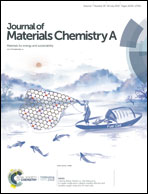Electrochemically scalable production of bilayer fluorographene nanosheets for solid-state supercapacitors†
Abstract
Fluorographene (FG) simultaneously possesses the merits of having a two-dimensional layer structure and distinctive properties because of fluorine incorporation, holding great promise as nanoelectronics and energy-storage materials. However, the large-scale exfoliation of bulk fluorinated graphite (FGi) into few-layered FG remains a challenge. Here we describe a novel and scalable electrochemical approach to exfoliate FGi into FG nanosheets using a designed Li-ion battery. The battery discharging process involves Li+ intercalation and LiF particle formation with a swelling effect for FGi exfoliation. The exfoliated FG nanosheets were characterized in detail and were only two layers thick (1.5 nm) and had a large lateral size (up to 1.4 μm) and a high fluorine content of 54.34%. Exfoliating FGi into bilayer FG nanosheets allows rapid mass transport and superior electron transfer, making it more suitable for energy-storage devices. When using bilayer FG nanosheets as the electrode in supercapacitor as a prototype, it delivered a specific capacitance of 99.1 F g−1 at a current density of 0.5 A g−1, which is about 9 times higher than that of an FGi electrode. Further application of the exfoliated bilayer FG nanosheets in solid-state supercapacitors has remarkable potential in electronics.



 Please wait while we load your content...
Please wait while we load your content...